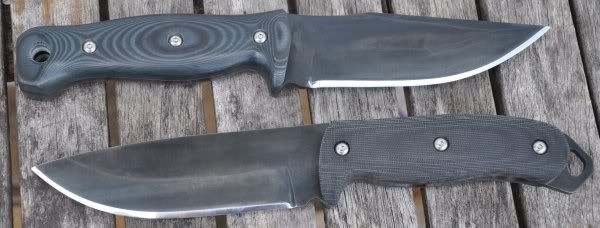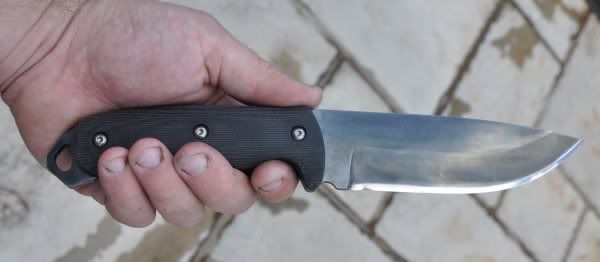Given the penchant for thick blades here, I can only imagine that Mors Kochanski must really struggle with those skinny little moras he uses. :borgsmile
Favorite blade thickness
- Thread starter ikesdad
- Start date
-
Come along to the amazing Summer Moot (21st July - 2nd August), a festival of bushcrafting and camping in a beautiful woodland PLEASE CLICK HERE for more information.
You are using an out of date browser. It may not display this or other websites correctly.
You should upgrade or use an alternative browser.
You should upgrade or use an alternative browser.
As a simple answer to the question, 4.5 to 5mm. But it's really all about geometry, not just the stock thickness. You can make a 6mm thick blade slice more efficiently than a 3mm blade given the right geometry, ('right' as in right for the example, not as in right or wrong.)
As a simple answer to the question, 4.5 to 5mm. But it's really all about geometry, not just the stock thickness. You can make a 6mm thick blade slice more efficiently than a 3mm blade given the right geometry, ('right' as in right for the example, not as in right or wrong.)
quite right liek a lot of things ie car Horse power or blade Rockwell hardness one figure dosnt give the whole story of what will or wont work or whats best at something etc
if your talking a 25deg scandi grind then for me 4mm is to thick and cumbersome but fine for 3mm stock but as said ealier i now use 6mm and thicker stock but remove more than half the metal to get a shape and geometry i like and works for me the edge is still the same 25deg bevel but its onl as wide as a 2mm knife at the grind line then angles up slowly to the spine
Due to the tapering profile this also naturally distal tapers the spine from 6mm to the 2mm at the tip. The profile angle changes for the front 1.5inch slightly so increasing the rate of change of the spine taper giving a fine working tip pretty much identical to the Mora the light weight and the carefull positioning of the balance point mean you can access the point easily and safely when choking up with out fatigue for reaonable periods. the very wide spine makes pushing with your thumb etc very comfortable
yes you can do all that with a 3mm blade tho is wont slice as easily
one big advantge is it solves a problem a lot of Full tang blades have . When flexed even a little you can pop the scales at the choil very easily as th flat blade flexes along its lenght evenly go on hold your knife spine on to teh light and flex it a littl like a Kit Kat you will probably see some light unde the scale where its come away or it will click as it does come away haveing the front Pin well fwds helps reduce this as does usingthe right glues etc . However haveing a distal tapered blade that point is the thickest and strongest point so the flexing is distributed waway from it
ATB
Duncan
...i now use 6mm and thicker stock but remove more than half the metal to get a shape and geometry i like and works for me the edge is still the same 25deg bevel but its onl as wide as a 2mm knife at the grind line ... the very wide spine makes pushing with your thumb etc very comfortable ... solves a problem a lot of Full tang blades have . When flexed even a little you can pop the scales at the choil very easily ...
Now that makes a lot of sense to me. You might just have found yourself a customer.
Hi Duncan,
Your comments run along similar lines as to why I prefer a thicker spine. Just to go off topic slightly though, why glue the scales at all? Why not just rely on the full tang to do its job of resisting lateral forces and let the scales do the simple job of 'filling the hand' and making the knife comfortable?
That way, when the knife flexes the scales will slide relative to the tang, (we're talking very small amounts here), and then when the knife flexes back, the scales will simply slide back into position. I realise that you would be losing the bonding strength, and thus the tang and scales will be acting separately rather than as a unit, but it's not as if the tang isn't still up to the job. It's one less step in the manufacturing process too.
Your comments run along similar lines as to why I prefer a thicker spine. Just to go off topic slightly though, why glue the scales at all? Why not just rely on the full tang to do its job of resisting lateral forces and let the scales do the simple job of 'filling the hand' and making the knife comfortable?
That way, when the knife flexes the scales will slide relative to the tang, (we're talking very small amounts here), and then when the knife flexes back, the scales will simply slide back into position. I realise that you would be losing the bonding strength, and thus the tang and scales will be acting separately rather than as a unit, but it's not as if the tang isn't still up to the job. It's one less step in the manufacturing process too.
with decent bolts/pins that aint a bad idea.
I have a 3mm bushy, I like, just got a 4mm from fygt, like it even more had tons of fun batoning this eve!
had tons of fun batoning this eve!
I have a 3mm bushy, I like, just got a 4mm from fygt, like it even more
Last edited:
Hi Duncan,
Your comments run along similar lines as to why I prefer a thicker spine. Just to go off topic slightly though, why glue the scales at all? Why not just rely on the full tang to do its job of resisting lateral forces and let the scales do the simple job of 'filling the hand' and making the knife comfortable?
That way, when the knife flexes the scales will slide relative to the tang, (we're talking very small amounts here), and then when the knife flexes back, the scales will simply slide back into position. I realise that you would be losing the bonding strength, and thus the tang and scales will be acting separately rather than as a unit, but it's not as if the tang isn't still up to the job. It's one less step in the manufacturing process too.
well I like the look of taper tangs and my 6mm blades get taper tanged to 1mm at the back and heavily drilled gluing is a lot easier as well plus i have thin scales at the front as the spine fills a lot of space you would need ot make them removable to clean and oil the tang stop rust etc on O1 ( yeh i know use stainless ) i dont like the idea of sliding scales means they can move which means they could end up not flush with the tang and that will cause a hotspot blister if carving for long enough

i have just done a couple of big tactical bushy knives (well finished them from last year )
thse are 3/16" (4.47mm) and wide blades so prety strong the scales are 3/8" Black Micarta nad green black G10 and are only bolted on so are removable but i had to make threaded bushes and drill acuratly and counter bore both sides of each scale etc tho i couldnt really glue thses scales as i would have removed the blacking on the spine (which also adds some rust protection)


theres lots of ways to make a knife
ATB
Duncan
with decent bolts/pins that aint a bad idea.
I have a 3mm bushy, I like, just got a 4mm from fygt, like it even morehad tons of fun batoning this eve!
so is there a picture i assume you have put some handles in
ATB
Duncan

theres lots of ways to make a knife
ATB
Duncan
Duncan, is that Devey569's Rat5?
hes gonna be over the moon when he gets it, what are the specs?
Duncan, is that Devey569's Rat5?
hes gonna be over the moon when he gets it, what are the specs?
Specs are its a Rat 5
Similar threads
- Replies
- 6
- Views
- 449
- Replies
- 0
- Views
- 242
- Replies
- 2
- Views
- 513
- Replies
- 0
- Views
- 274
- Replies
- 9
- Views
- 860
